COU202 Counselling Practice: Egan's Skilled Helper Model Report
VerifiedAdded on 2022/09/22
|8
|1668
|35
Report
AI Summary
This report provides a comprehensive overview of Gerard Egan's Skilled Helper Model, a widely used framework in counseling, training, and mentoring contexts. The model is designed to empower clients to address their difficulties, find their own solutions, and explore opportunities for personal growth. The report details the three stages of the model: Stage 1 focuses on understanding the client's situation through active listening, empathy, and questioning; Stage 2 challenges existing views and facilitates goal setting; and Stage 3 involves action planning. The report includes examples of how the model is applied in clinical scenarios, discusses the model's usefulness, and analyzes its pros and cons, including its flexibility and limitations. The report also references key scholarly sources to support its analysis.

Running Head: SHM
0
Skilled Helper model
student
9/7/2019
0
Skilled Helper model
student
9/7/2019
Paraphrase This Document
Need a fresh take? Get an instant paraphrase of this document with our AI Paraphraser
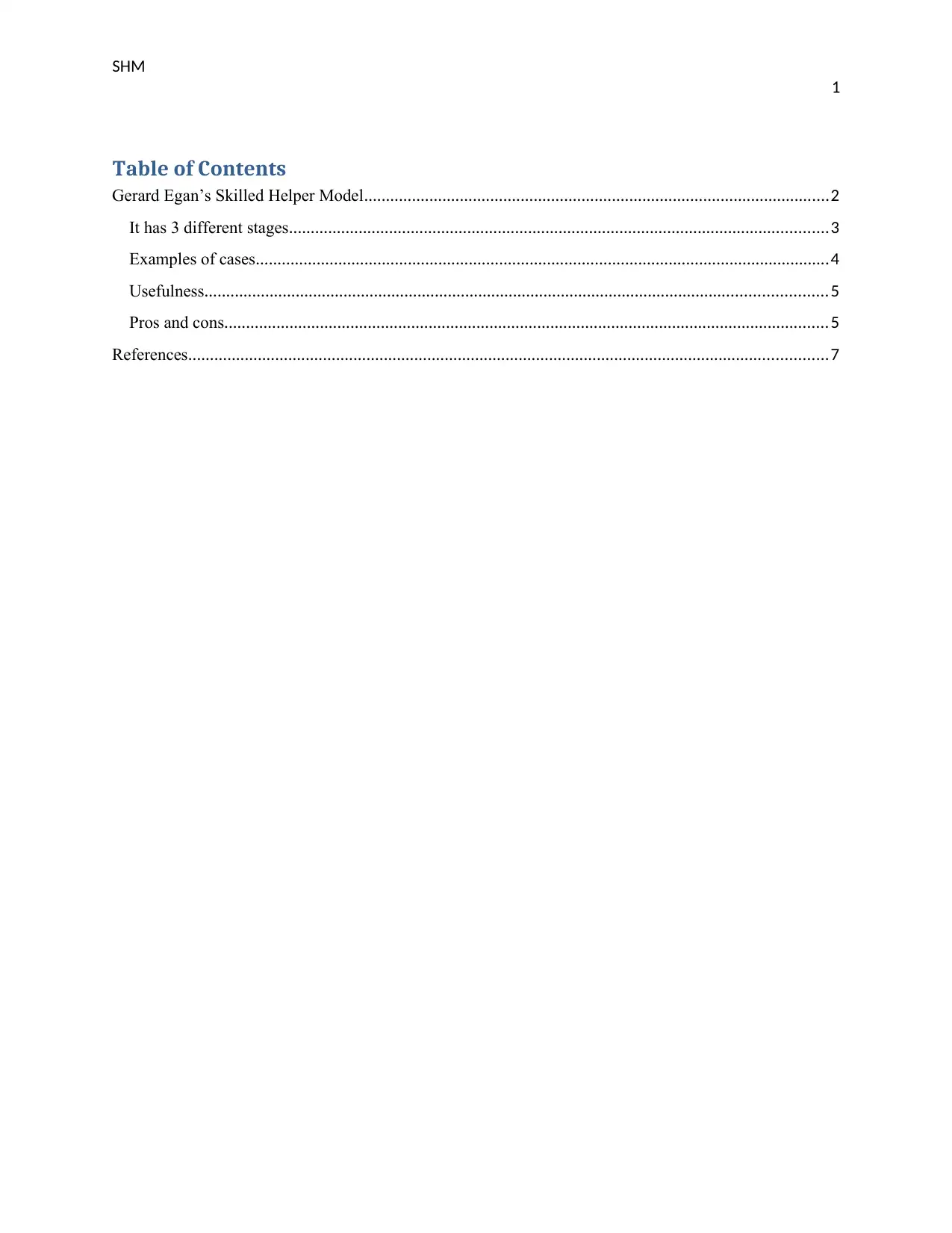
SHM
1
Table of Contents
Gerard Egan’s Skilled Helper Model...........................................................................................................2
It has 3 different stages............................................................................................................................3
Examples of cases....................................................................................................................................4
Usefulness...............................................................................................................................................5
Pros and cons...........................................................................................................................................5
References...................................................................................................................................................7
1
Table of Contents
Gerard Egan’s Skilled Helper Model...........................................................................................................2
It has 3 different stages............................................................................................................................3
Examples of cases....................................................................................................................................4
Usefulness...............................................................................................................................................5
Pros and cons...........................................................................................................................................5
References...................................................................................................................................................7
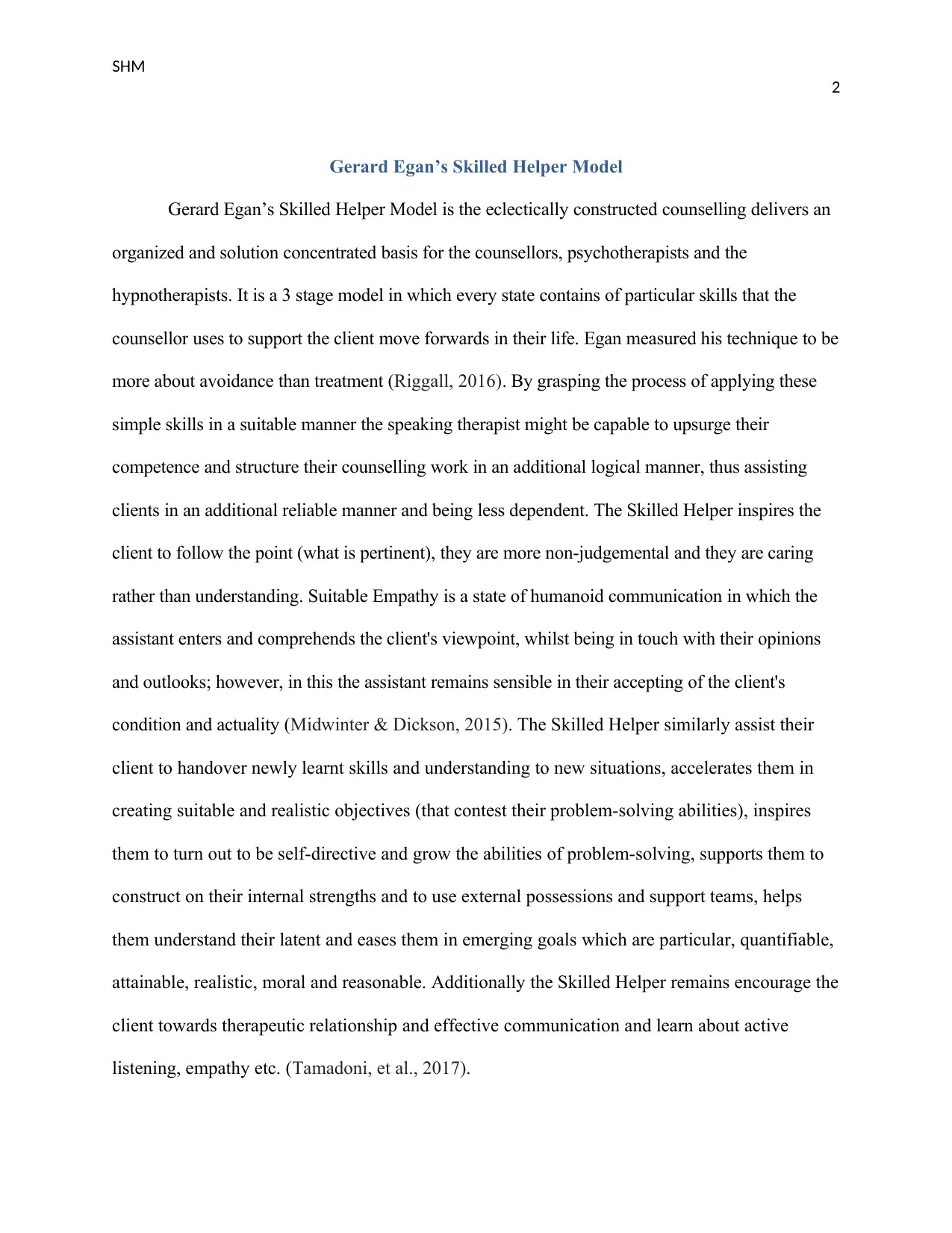
SHM
2
Gerard Egan’s Skilled Helper Model
Gerard Egan’s Skilled Helper Model is the eclectically constructed counselling delivers an
organized and solution concentrated basis for the counsellors, psychotherapists and the
hypnotherapists. It is a 3 stage model in which every state contains of particular skills that the
counsellor uses to support the client move forwards in their life. Egan measured his technique to be
more about avoidance than treatment (Riggall, 2016). By grasping the process of applying these
simple skills in a suitable manner the speaking therapist might be capable to upsurge their
competence and structure their counselling work in an additional logical manner, thus assisting
clients in an additional reliable manner and being less dependent. The Skilled Helper inspires the
client to follow the point (what is pertinent), they are more non-judgemental and they are caring
rather than understanding. Suitable Empathy is a state of humanoid communication in which the
assistant enters and comprehends the client's viewpoint, whilst being in touch with their opinions
and outlooks; however, in this the assistant remains sensible in their accepting of the client's
condition and actuality (Midwinter & Dickson, 2015). The Skilled Helper similarly assist their
client to handover newly learnt skills and understanding to new situations, accelerates them in
creating suitable and realistic objectives (that contest their problem-solving abilities), inspires
them to turn out to be self-directive and grow the abilities of problem-solving, supports them to
construct on their internal strengths and to use external possessions and support teams, helps
them understand their latent and eases them in emerging goals which are particular, quantifiable,
attainable, realistic, moral and reasonable. Additionally the Skilled Helper remains encourage the
client towards therapeutic relationship and effective communication and learn about active
listening, empathy etc. (Tamadoni, et al., 2017).
2
Gerard Egan’s Skilled Helper Model
Gerard Egan’s Skilled Helper Model is the eclectically constructed counselling delivers an
organized and solution concentrated basis for the counsellors, psychotherapists and the
hypnotherapists. It is a 3 stage model in which every state contains of particular skills that the
counsellor uses to support the client move forwards in their life. Egan measured his technique to be
more about avoidance than treatment (Riggall, 2016). By grasping the process of applying these
simple skills in a suitable manner the speaking therapist might be capable to upsurge their
competence and structure their counselling work in an additional logical manner, thus assisting
clients in an additional reliable manner and being less dependent. The Skilled Helper inspires the
client to follow the point (what is pertinent), they are more non-judgemental and they are caring
rather than understanding. Suitable Empathy is a state of humanoid communication in which the
assistant enters and comprehends the client's viewpoint, whilst being in touch with their opinions
and outlooks; however, in this the assistant remains sensible in their accepting of the client's
condition and actuality (Midwinter & Dickson, 2015). The Skilled Helper similarly assist their
client to handover newly learnt skills and understanding to new situations, accelerates them in
creating suitable and realistic objectives (that contest their problem-solving abilities), inspires
them to turn out to be self-directive and grow the abilities of problem-solving, supports them to
construct on their internal strengths and to use external possessions and support teams, helps
them understand their latent and eases them in emerging goals which are particular, quantifiable,
attainable, realistic, moral and reasonable. Additionally the Skilled Helper remains encourage the
client towards therapeutic relationship and effective communication and learn about active
listening, empathy etc. (Tamadoni, et al., 2017).
⊘ This is a preview!⊘
Do you want full access?
Subscribe today to unlock all pages.

Trusted by 1+ million students worldwide
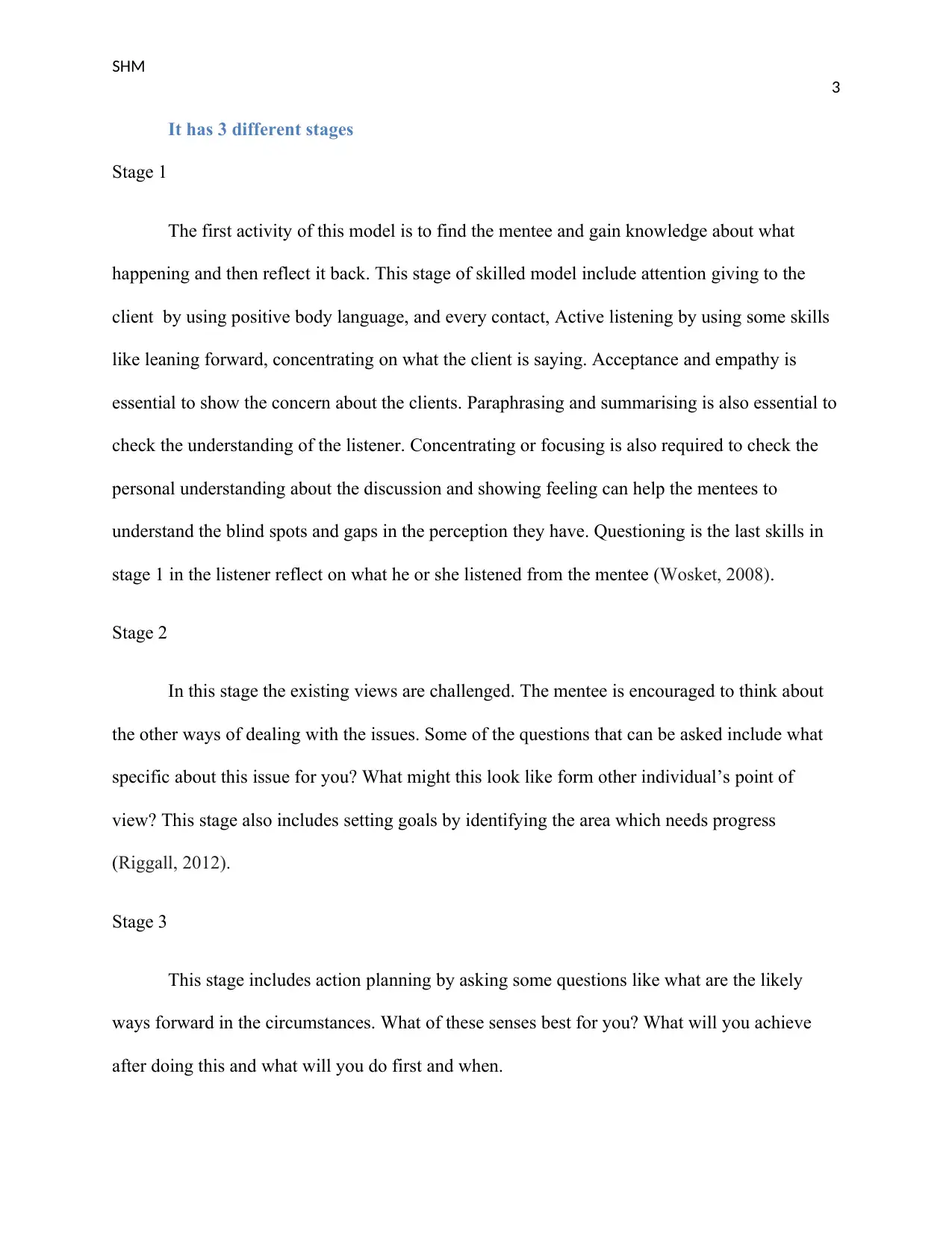
SHM
3
It has 3 different stages
Stage 1
The first activity of this model is to find the mentee and gain knowledge about what
happening and then reflect it back. This stage of skilled model include attention giving to the
client by using positive body language, and every contact, Active listening by using some skills
like leaning forward, concentrating on what the client is saying. Acceptance and empathy is
essential to show the concern about the clients. Paraphrasing and summarising is also essential to
check the understanding of the listener. Concentrating or focusing is also required to check the
personal understanding about the discussion and showing feeling can help the mentees to
understand the blind spots and gaps in the perception they have. Questioning is the last skills in
stage 1 in the listener reflect on what he or she listened from the mentee (Wosket, 2008).
Stage 2
In this stage the existing views are challenged. The mentee is encouraged to think about
the other ways of dealing with the issues. Some of the questions that can be asked include what
specific about this issue for you? What might this look like form other individual’s point of
view? This stage also includes setting goals by identifying the area which needs progress
(Riggall, 2012).
Stage 3
This stage includes action planning by asking some questions like what are the likely
ways forward in the circumstances. What of these senses best for you? What will you achieve
after doing this and what will you do first and when.
3
It has 3 different stages
Stage 1
The first activity of this model is to find the mentee and gain knowledge about what
happening and then reflect it back. This stage of skilled model include attention giving to the
client by using positive body language, and every contact, Active listening by using some skills
like leaning forward, concentrating on what the client is saying. Acceptance and empathy is
essential to show the concern about the clients. Paraphrasing and summarising is also essential to
check the understanding of the listener. Concentrating or focusing is also required to check the
personal understanding about the discussion and showing feeling can help the mentees to
understand the blind spots and gaps in the perception they have. Questioning is the last skills in
stage 1 in the listener reflect on what he or she listened from the mentee (Wosket, 2008).
Stage 2
In this stage the existing views are challenged. The mentee is encouraged to think about
the other ways of dealing with the issues. Some of the questions that can be asked include what
specific about this issue for you? What might this look like form other individual’s point of
view? This stage also includes setting goals by identifying the area which needs progress
(Riggall, 2012).
Stage 3
This stage includes action planning by asking some questions like what are the likely
ways forward in the circumstances. What of these senses best for you? What will you achieve
after doing this and what will you do first and when.
Paraphrase This Document
Need a fresh take? Get an instant paraphrase of this document with our AI Paraphraser
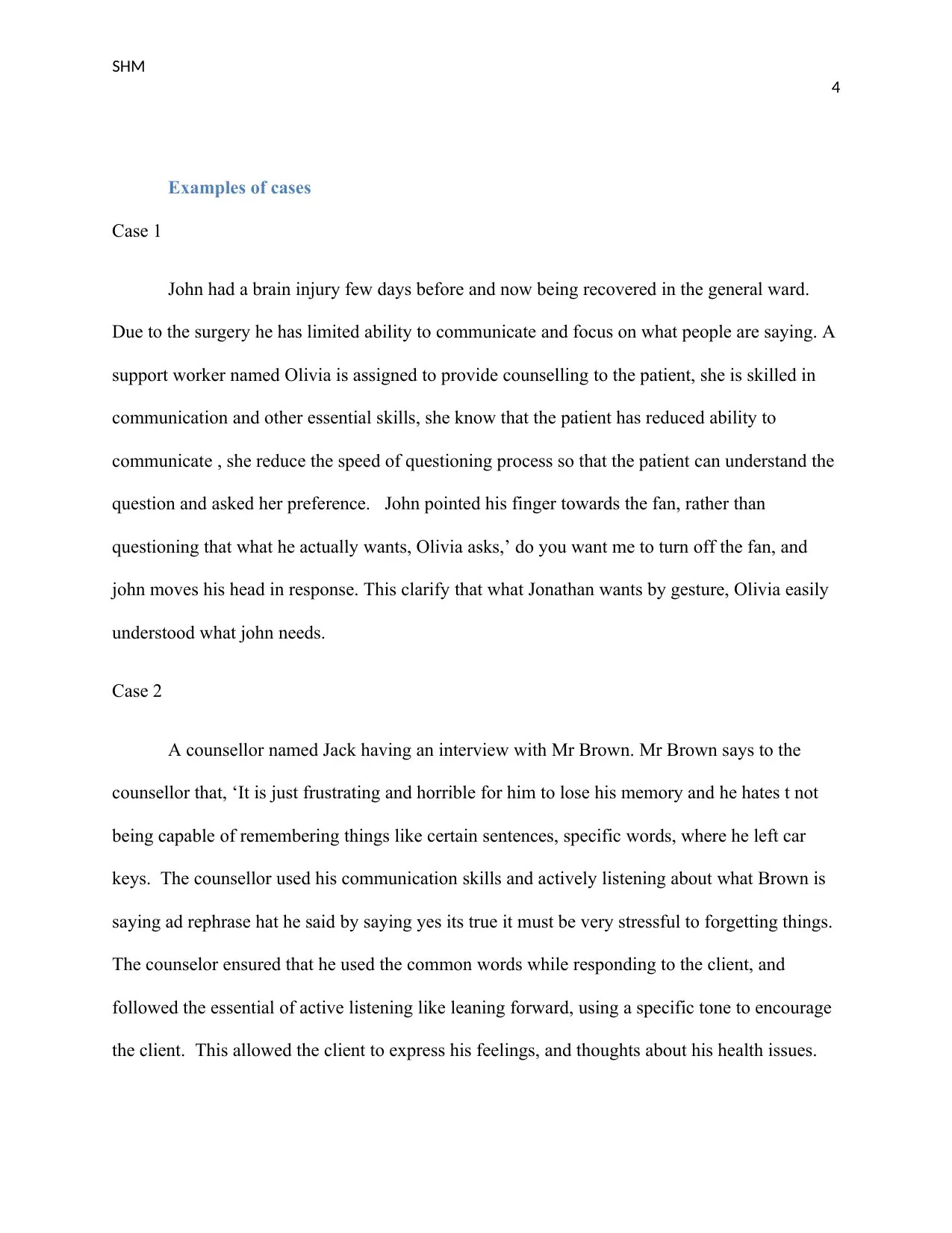
SHM
4
Examples of cases
Case 1
John had a brain injury few days before and now being recovered in the general ward.
Due to the surgery he has limited ability to communicate and focus on what people are saying. A
support worker named Olivia is assigned to provide counselling to the patient, she is skilled in
communication and other essential skills, she know that the patient has reduced ability to
communicate , she reduce the speed of questioning process so that the patient can understand the
question and asked her preference. John pointed his finger towards the fan, rather than
questioning that what he actually wants, Olivia asks,’ do you want me to turn off the fan, and
john moves his head in response. This clarify that what Jonathan wants by gesture, Olivia easily
understood what john needs.
Case 2
A counsellor named Jack having an interview with Mr Brown. Mr Brown says to the
counsellor that, ‘It is just frustrating and horrible for him to lose his memory and he hates t not
being capable of remembering things like certain sentences, specific words, where he left car
keys. The counsellor used his communication skills and actively listening about what Brown is
saying ad rephrase hat he said by saying yes its true it must be very stressful to forgetting things.
The counselor ensured that he used the common words while responding to the client, and
followed the essential of active listening like leaning forward, using a specific tone to encourage
the client. This allowed the client to express his feelings, and thoughts about his health issues.
4
Examples of cases
Case 1
John had a brain injury few days before and now being recovered in the general ward.
Due to the surgery he has limited ability to communicate and focus on what people are saying. A
support worker named Olivia is assigned to provide counselling to the patient, she is skilled in
communication and other essential skills, she know that the patient has reduced ability to
communicate , she reduce the speed of questioning process so that the patient can understand the
question and asked her preference. John pointed his finger towards the fan, rather than
questioning that what he actually wants, Olivia asks,’ do you want me to turn off the fan, and
john moves his head in response. This clarify that what Jonathan wants by gesture, Olivia easily
understood what john needs.
Case 2
A counsellor named Jack having an interview with Mr Brown. Mr Brown says to the
counsellor that, ‘It is just frustrating and horrible for him to lose his memory and he hates t not
being capable of remembering things like certain sentences, specific words, where he left car
keys. The counsellor used his communication skills and actively listening about what Brown is
saying ad rephrase hat he said by saying yes its true it must be very stressful to forgetting things.
The counselor ensured that he used the common words while responding to the client, and
followed the essential of active listening like leaning forward, using a specific tone to encourage
the client. This allowed the client to express his feelings, and thoughts about his health issues.
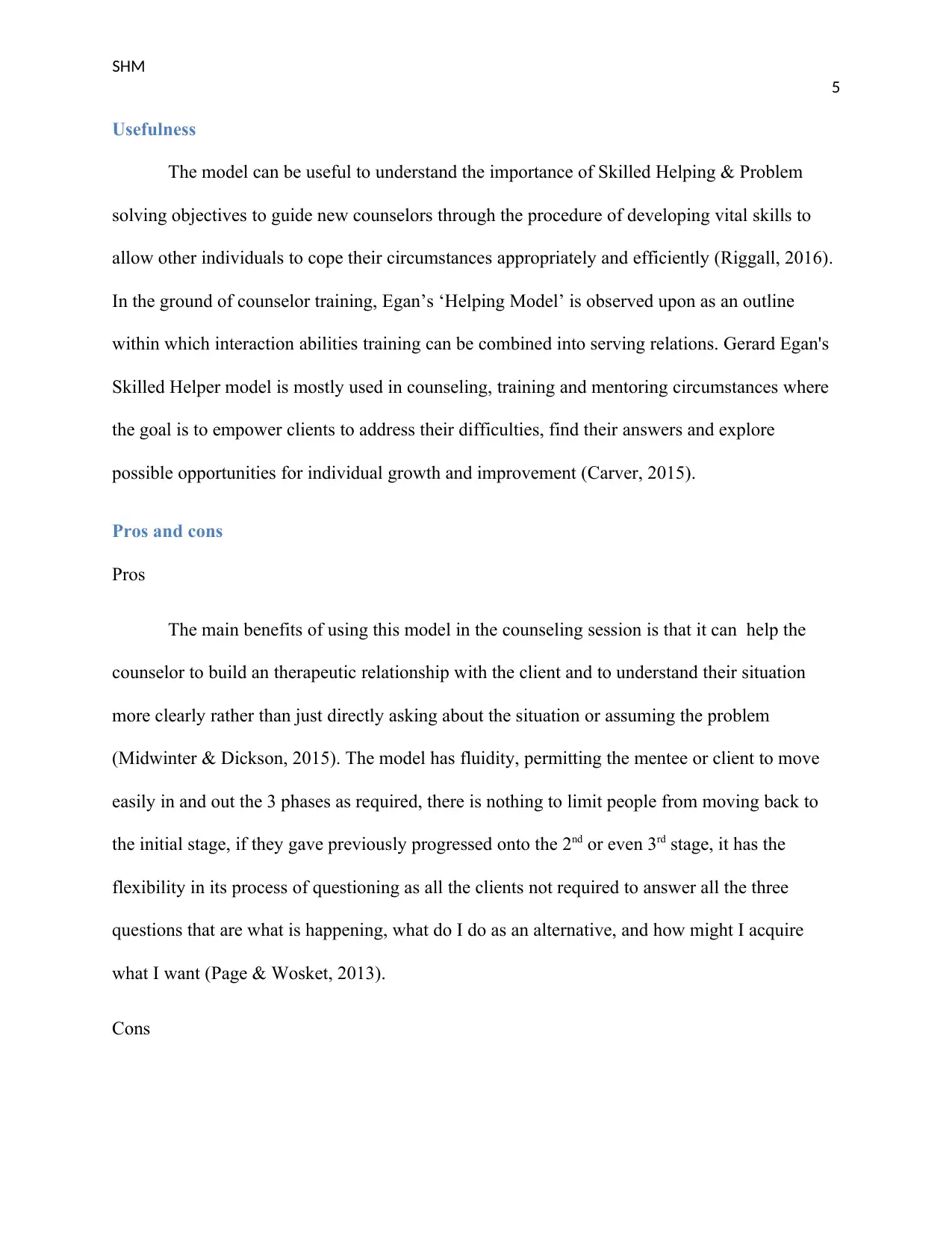
SHM
5
Usefulness
The model can be useful to understand the importance of Skilled Helping & Problem
solving objectives to guide new counselors through the procedure of developing vital skills to
allow other individuals to cope their circumstances appropriately and efficiently (Riggall, 2016).
In the ground of counselor training, Egan’s ‘Helping Model’ is observed upon as an outline
within which interaction abilities training can be combined into serving relations. Gerard Egan's
Skilled Helper model is mostly used in counseling, training and mentoring circumstances where
the goal is to empower clients to address their difficulties, find their answers and explore
possible opportunities for individual growth and improvement (Carver, 2015).
Pros and cons
Pros
The main benefits of using this model in the counseling session is that it can help the
counselor to build an therapeutic relationship with the client and to understand their situation
more clearly rather than just directly asking about the situation or assuming the problem
(Midwinter & Dickson, 2015). The model has fluidity, permitting the mentee or client to move
easily in and out the 3 phases as required, there is nothing to limit people from moving back to
the initial stage, if they gave previously progressed onto the 2nd or even 3rd stage, it has the
flexibility in its process of questioning as all the clients not required to answer all the three
questions that are what is happening, what do I do as an alternative, and how might I acquire
what I want (Page & Wosket, 2013).
Cons
5
Usefulness
The model can be useful to understand the importance of Skilled Helping & Problem
solving objectives to guide new counselors through the procedure of developing vital skills to
allow other individuals to cope their circumstances appropriately and efficiently (Riggall, 2016).
In the ground of counselor training, Egan’s ‘Helping Model’ is observed upon as an outline
within which interaction abilities training can be combined into serving relations. Gerard Egan's
Skilled Helper model is mostly used in counseling, training and mentoring circumstances where
the goal is to empower clients to address their difficulties, find their answers and explore
possible opportunities for individual growth and improvement (Carver, 2015).
Pros and cons
Pros
The main benefits of using this model in the counseling session is that it can help the
counselor to build an therapeutic relationship with the client and to understand their situation
more clearly rather than just directly asking about the situation or assuming the problem
(Midwinter & Dickson, 2015). The model has fluidity, permitting the mentee or client to move
easily in and out the 3 phases as required, there is nothing to limit people from moving back to
the initial stage, if they gave previously progressed onto the 2nd or even 3rd stage, it has the
flexibility in its process of questioning as all the clients not required to answer all the three
questions that are what is happening, what do I do as an alternative, and how might I acquire
what I want (Page & Wosket, 2013).
Cons
⊘ This is a preview!⊘
Do you want full access?
Subscribe today to unlock all pages.

Trusted by 1+ million students worldwide
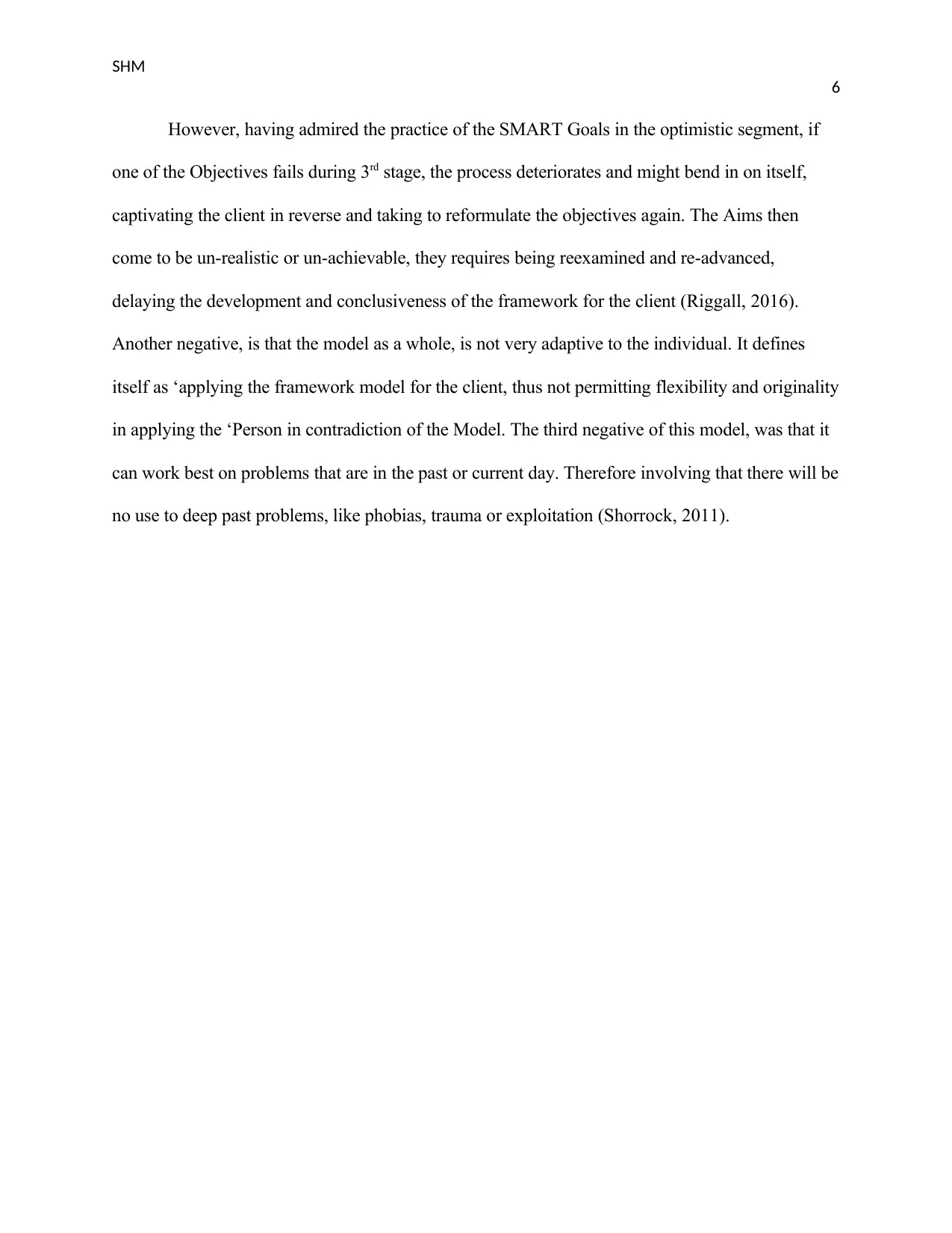
SHM
6
However, having admired the practice of the SMART Goals in the optimistic segment, if
one of the Objectives fails during 3rd stage, the process deteriorates and might bend in on itself,
captivating the client in reverse and taking to reformulate the objectives again. The Aims then
come to be un-realistic or un-achievable, they requires being reexamined and re-advanced,
delaying the development and conclusiveness of the framework for the client (Riggall, 2016).
Another negative, is that the model as a whole, is not very adaptive to the individual. It defines
itself as ‘applying the framework model for the client, thus not permitting flexibility and originality
in applying the ‘Person in contradiction of the Model. The third negative of this model, was that it
can work best on problems that are in the past or current day. Therefore involving that there will be
no use to deep past problems, like phobias, trauma or exploitation (Shorrock, 2011).
6
However, having admired the practice of the SMART Goals in the optimistic segment, if
one of the Objectives fails during 3rd stage, the process deteriorates and might bend in on itself,
captivating the client in reverse and taking to reformulate the objectives again. The Aims then
come to be un-realistic or un-achievable, they requires being reexamined and re-advanced,
delaying the development and conclusiveness of the framework for the client (Riggall, 2016).
Another negative, is that the model as a whole, is not very adaptive to the individual. It defines
itself as ‘applying the framework model for the client, thus not permitting flexibility and originality
in applying the ‘Person in contradiction of the Model. The third negative of this model, was that it
can work best on problems that are in the past or current day. Therefore involving that there will be
no use to deep past problems, like phobias, trauma or exploitation (Shorrock, 2011).
Paraphrase This Document
Need a fresh take? Get an instant paraphrase of this document with our AI Paraphraser
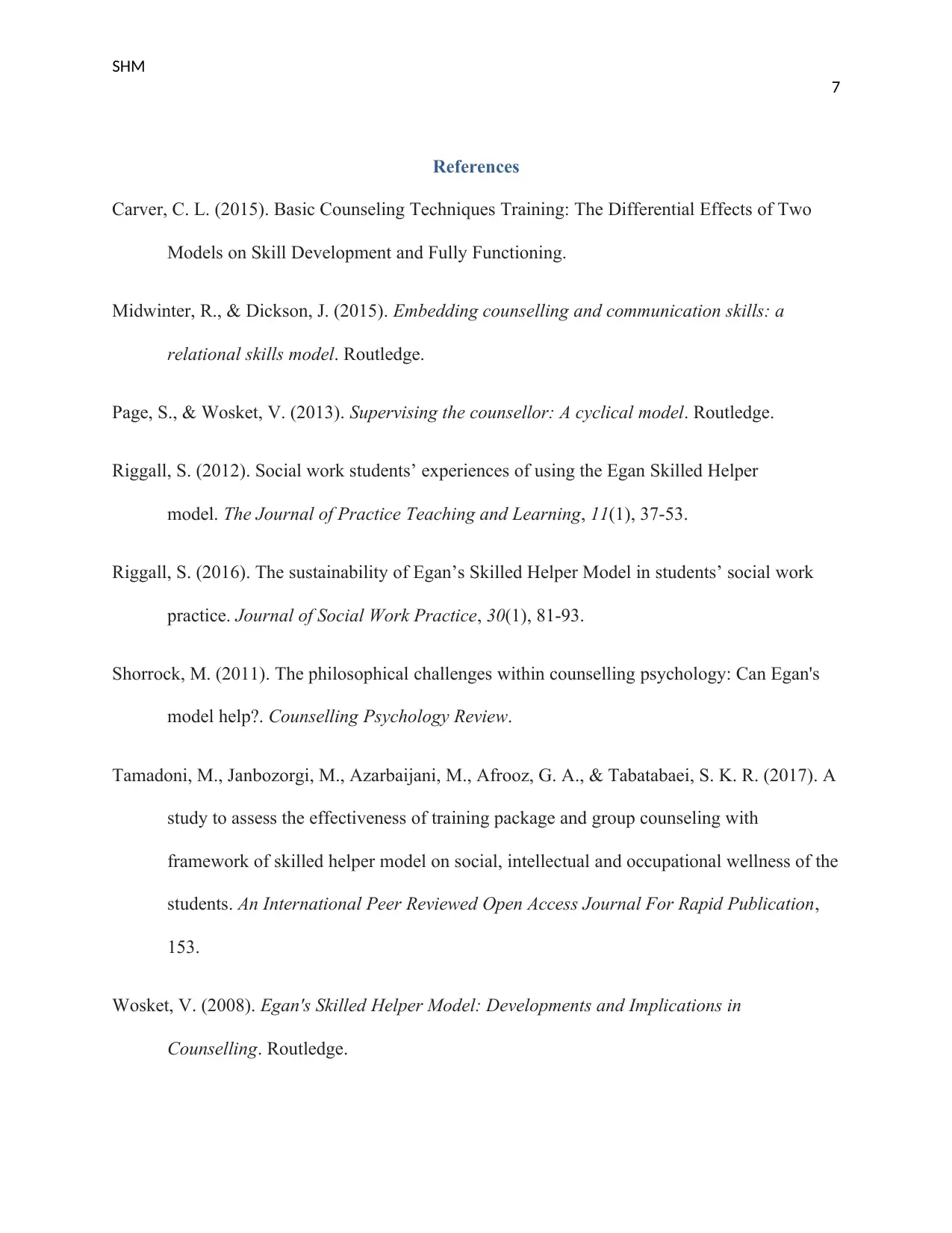
SHM
7
References
Carver, C. L. (2015). Basic Counseling Techniques Training: The Differential Effects of Two
Models on Skill Development and Fully Functioning.
Midwinter, R., & Dickson, J. (2015). Embedding counselling and communication skills: a
relational skills model. Routledge.
Page, S., & Wosket, V. (2013). Supervising the counsellor: A cyclical model. Routledge.
Riggall, S. (2012). Social work students’ experiences of using the Egan Skilled Helper
model. The Journal of Practice Teaching and Learning, 11(1), 37-53.
Riggall, S. (2016). The sustainability of Egan’s Skilled Helper Model in students’ social work
practice. Journal of Social Work Practice, 30(1), 81-93.
Shorrock, M. (2011). The philosophical challenges within counselling psychology: Can Egan's
model help?. Counselling Psychology Review.
Tamadoni, M., Janbozorgi, M., Azarbaijani, M., Afrooz, G. A., & Tabatabaei, S. K. R. (2017). A
study to assess the effectiveness of training package and group counseling with
framework of skilled helper model on social, intellectual and occupational wellness of the
students. An International Peer Reviewed Open Access Journal For Rapid Publication,
153.
Wosket, V. (2008). Egan's Skilled Helper Model: Developments and Implications in
Counselling. Routledge.
7
References
Carver, C. L. (2015). Basic Counseling Techniques Training: The Differential Effects of Two
Models on Skill Development and Fully Functioning.
Midwinter, R., & Dickson, J. (2015). Embedding counselling and communication skills: a
relational skills model. Routledge.
Page, S., & Wosket, V. (2013). Supervising the counsellor: A cyclical model. Routledge.
Riggall, S. (2012). Social work students’ experiences of using the Egan Skilled Helper
model. The Journal of Practice Teaching and Learning, 11(1), 37-53.
Riggall, S. (2016). The sustainability of Egan’s Skilled Helper Model in students’ social work
practice. Journal of Social Work Practice, 30(1), 81-93.
Shorrock, M. (2011). The philosophical challenges within counselling psychology: Can Egan's
model help?. Counselling Psychology Review.
Tamadoni, M., Janbozorgi, M., Azarbaijani, M., Afrooz, G. A., & Tabatabaei, S. K. R. (2017). A
study to assess the effectiveness of training package and group counseling with
framework of skilled helper model on social, intellectual and occupational wellness of the
students. An International Peer Reviewed Open Access Journal For Rapid Publication,
153.
Wosket, V. (2008). Egan's Skilled Helper Model: Developments and Implications in
Counselling. Routledge.
1 out of 8
Related Documents
Your All-in-One AI-Powered Toolkit for Academic Success.
+13062052269
info@desklib.com
Available 24*7 on WhatsApp / Email
![[object Object]](/_next/static/media/star-bottom.7253800d.svg)
Unlock your academic potential
Copyright © 2020–2025 A2Z Services. All Rights Reserved. Developed and managed by ZUCOL.





